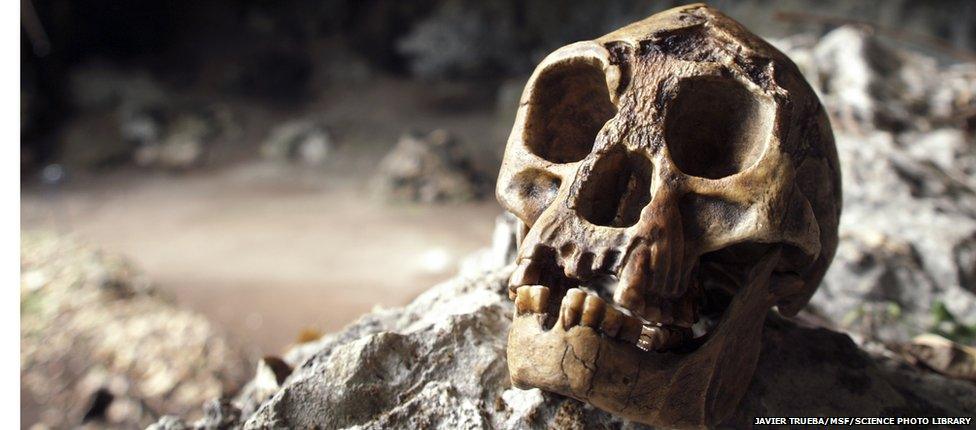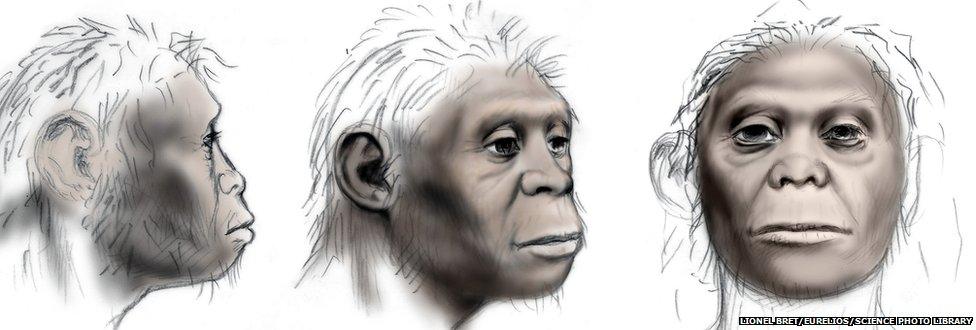'The Hobbit' turns 10: Find that rewrote human history
- Published

The discovery of a tiny species of human 10 years ago, external has transformed theories of human evolution.
The claim is made by Prof Richard Roberts who was among those to have published details of the "Hobbit".
The early human was thought to have lived as recently as 20,000 years ago and so walked the Earth at the same time as our species.
The Hobbit's discovery confirmed the view that the Earth was once populated by many species of human.
It's a far cry from the old view of a linear progression from knuckle-dragging ape-like creatures to upright modern people.
Prof Roberts says the discovery of a completely different species of human on the Indonesian Island of Flores that lived until relatively recently, "put paid to this cosy status quo in one fell swoop".
There are many puzzles that remain about the Hobbit. The female skeleton was 1m (3ft) high and was a very primitive form of human. Her brain was about the size of a chimpanzee, yet there is evidence that she used stone tools.
Dr Henry Gee, the manuscript editor who decided to publish the paper in the journal Nature, said that it gradually dawned on him just how important the discovery was.
"It is the biggest paper I have been involved with," he told BBC News.
"It surpassed anything else I'd been involved with because it just kept running. People kept on talking about it and it became part of popular culture and a sign of a new view of anthropology. The days of the old linear models of anthropology were gone.
The publication of the discovery on the Indonesian Island of Flores in October 2004, caused a sensation. The news that another species of human walked among us until relatively recently stunned the world.
There were even questions about whether the Hobbit, named Homo floresiensis, still existed somewhere on the island. Perhaps there were other species of humans in other very remote parts of the world yet to be discovered?
The notion that our species, Homo sapiens, was the only species of human on the planet was for the first time in thousands of years in doubt. Perhaps tales of yetis, giants and leprechauns have a basis from our distant evolutionary past.
As it turned out no more fossilised remains of the Hobbit have been unearthed since then, let alone the discovery of creatures from folklore. But those involved in the field are convinced that much more is yet to come, according to Prof Roberts.
"The discovery of the Hobbit has opened up the credible possibility of other undiscovered human species being 'out there', perhaps buried metres underground like the Hobbit, or tucked away in a museum drawer, unrecognised for what it truly is - another new species, but misidentified as an 'unusual' modern human or an earlier species of human well-known to science," he told BBC News.
"I think the discovery of the Hobbit helped create an atmosphere in which it's okay to expect the unexpected, and that we shouldn't get fooled into thinking that we have all the answers, ever."
Mystery arrival
The Hobbit's existence on Flores is still a complete mystery. How did it get there? Flores is east of the so-called Wallace Line which demarcates islands that have rarely - if ever - been connected via land bridges to the Asian mainland. So did this early, very primitive species of human have the wherewithal to build boats and sail across the sea?
Many believe that the Hobbit stems from an earlier form of human called Homo erectus which arrived on the island around a million years ago and gradually became smaller over generations through living on an island, where there were scant food resources.
Others believe that its origins are from ape-like creatures which left Africa more than two million years ago. Critics even proposed that the creatures were the remains of seriously ill modern humans. , external

The sensational discovery was made in the Liang Bua cave in Flores Indonesia. Are further remains to be found?
Prof Roberts told BBC News that the team never seriously thought that they would stumble across a new species of human. The researchers had been looking for the ancestors of the first Aboriginal Australians. At that time, the question of when Australia was first settled by Homo sapiens was hotly contested.
So his reaction to discovering the diminutive partial skeleton, he said, was "a mix of utter puzzlement and extreme excitement".
The research team was convinced that the remains were clearly not those of a modern human - not even one with a medical condition.
"I was absolutely mystified. It wasn't the early modern human skeleton we'd been hoping to find, but what was it?
"Something completely new to science as it turned out - but that's the beauty of serendipity. And it also goes to show the value of keeping archaeology 'real' and carrying out excavations, rather than relying on gee-whizz technology and computer modelling to provide all the answers.
"If we'd not done any digging, the world would be none the wiser that this creature had ever inhabited this part of the planet."
More bones of H. floresiensis have been found, but no new skulls as yet. The same team that discovered the Hobbit is continuing excavations in the hope that they will find more clues. And there is still the possibility that there might be remains of similar creatures elsewhere in the region, according to Prof Chris Stringer, of the Natural History Museum in London.

Artist's impression of the Hobbit - a small brain but able to use stone tools. One of the big outstanding questions is how did they get to Flores?
"There is the possibility that the experiment that produced the Hobbit could have produced similar experiments on other islands in the region, in Sulawesi, the Philippines and Timor and are awaiting discovery.
The scientific priority now for the group is to build up a picture of how the species was distributed, when it first arrived on Flores and when and why it finally went extinct.
"There's still much for us to learn about the Hobbit", explains Prof Roberts. "How its eccentric anatomical features came to be so, and whether Hobbits ever encountered early modern humans dispersing across Asia and south to Australia. Which is why, 10 years down the Hobbit track, it still feels like the journey of discovery has only just begun".